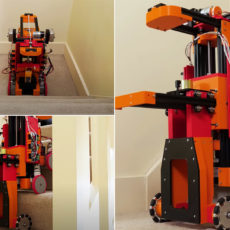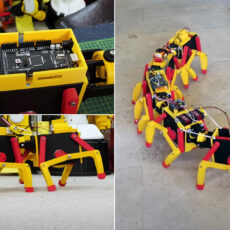
James Bruton, an inventor and YouTuber, made a one-wheeled, self-balancing robot inspired by the OneWheel but done his own way. Different from a ready-made OneWheel, which uses a wide tire and a refined control system, Bruton’s prototype is built from scratch, highlighting experimentation and open-source design.
Bruton’s robot uses one omni wheel with two motors to balance itself in two directions. The first motor spins the whole omni wheel in the usual way (forward and backward). It basically powers the wheel’s main rotation, like a hub motor in a OneWheel, to keep balance along the forward-backward direction or move the robot.
- 【7'' 10K High Resolution】Photon Mono 4 boasts an impressive 105% increase in print precision compared to Mono 2. With a resolution of 9024x5120,...
- 【Powerful Light Source】The time-tested Anycubic LighTurbo matrix light source technology delivers stable, balanced, and uniform lighting to reduce...
- 【Sufficient Print Size】With a generous maximum build volume of 6.04'' x 3.42'' x 6.49''/153.4mm x 87mm x 165mm, you have ample print space to...

A second motor turns the rollers on the omni wheel side-to-side, at a right angle to the main spin. This motor works with a belt and pulley system, kind of like a planetary gearbox, to move the rollers, helping the robot adjust its side-to-side balance.

Unlike a hoverboard or OneWheel, which only balances forward and backward, this robot balances in two directions (forward-backward and side-to-side). The omni wheel with two motors makes this possible by letting the wheel’s spin and roller movements be controlled separately.

A Teensy 4.0 microcontroller works as the main brain, handling sensor info and directing the motor to stay balanced and react to the rider’s moves. This board sends instructions to the VESC (Vedder Electronic Speed Controller), which runs the hub motor in the wheel.

The key thing for anyone wanting to make their own is that he uses ready-made parts and 3D-printed pieces, so hobbyists can copy it. That said, you’ll still need a lot of tech know-how to put it all together into a working one-wheeled robot.

While the current model doesn’t have a deck, Bruton’s step-by-step approach means he might add one later if he looks into making it rideable. The control system (tilt-responsive PID) could, in theory, support a rider, but without a deck and with a focus on “standing still,” it’s mainly about robotic independence.
All things considered, the results do look pretty good. It doesn’t really move around—Bruton tried steering it with his universal remote, but that didn’t work well. Still, it does a great job staying balanced in one spot, even when pushed.
[Source]













